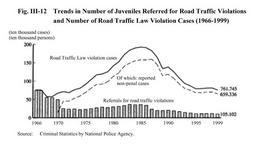| Previous Next Index Image Index Year Selection | |
|
|
3 Traffic offenses Fig. III-12 shows the number of juveniles referred by the police for road traffic violations and the number of Road Traffic Law violation cases related to driving(the number of reported non-penal cases and the number of referrals for penal cases)since 1966.
The number of juveniles referred for road traffic violations has been decreasing in general since 1987, when the scope of application of the traffic infraction notification system was expanded, and numbered 105, 102 in 1999(down 7.4% from the previous year). Meanwhile, the number of juvenile Road Traffic Law violation cases increased rapidly from the early 1970s and peaked at 1.94 million cases in 1985. It has tended to decline ever since. Cases in 1999 numbered 761,745, of which 659,336 (86.6%) were reported as non-penal cases. As regards types of violation in penal cases involving juveniles, driving without a license had the largest share (45.3%) in the total number of cases, followed by speeding (23.7%), driving while intoxicated (8.6%), and seating capacity violations (5.5%). As compared with adult cases, the ratio of driving without a license was significantly higher (5.1% for adults) in juvenile cases. Hot-rodding, a typical form of juvenile traffic delinquency, will be described in subsection 4-2 of this chapter. Fig. III-12 Trends in Number of Juveniles Referred for Road Traffic Violations and Number of Road Traffic Law Violation Cases (1966-1999) |
